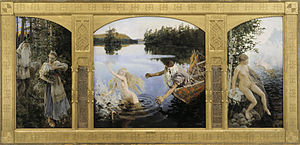
Aino (Finnish pronunciation: [ˈɑi̯no]) is a figure in the Finnish national epic Kalevala.
Description
It relates that she was the beautiful sister of Joukahainen. Her brother, having lost a singing contest to the storied Väinämöinen, promised Aino's "hands and feet" in marriage if Väinämöinen would save him from drowning in the swamp into which Joukahainen had been thrown. Aino's mother was pleased at the idea of marrying her daughter to such a famous and well-born person, but Aino did not want to marry such an old man. Rather than submit to this fate, Aino drowned herself (or was transformed into a nixie). However, she returned to taunt the grieving Väinämöinen as a perch.
The name Aino, meaning "the only one", was invented by Elias Lönnrot who composed the Kalevala. In the original poems she was mentioned as "the only daughter" or "the only sister" (aino tyttönen, aino sisko).
National romanticism
During the national romantic period at the end of the 19th century the mythological name Aino was adopted as a Christian name by Fennoman activists. Among the first to be named so were Aino Järnefelt (Aino Sibelius), born 1871 and Aino Krohn (the later Aino Kallas), born 1878.
According to the Finnish Population Register Centre, over 60,000 women have been given the name. It was especially popular in the early 20th century, and the most common first name for women in the 1920s. It has returned to favor in the 21st century; it was the most popular name for girls in Finland in 2006 and 2007.
Gallery
-
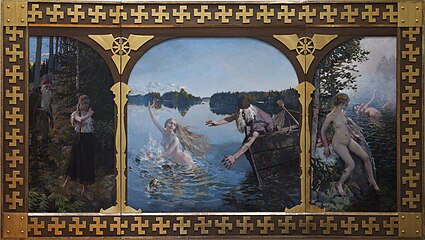 The earlier 1889 version of the triptych by Gallen-Kallela where Aino had the likeness of a French model
The earlier 1889 version of the triptych by Gallen-Kallela where Aino had the likeness of a French model
-
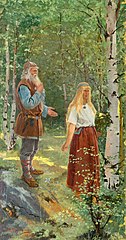 Väinämöinen and Aino, Sigfrid Keinänen [fi], 1896
Väinämöinen and Aino, Sigfrid Keinänen [fi], 1896
-
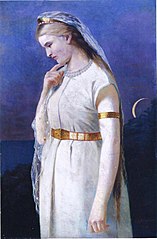 Aino by the Sea, Sigfrid Keinänen, 1876
Aino by the Sea, Sigfrid Keinänen, 1876
-
 Aino, watercolor by Albert Edelfelt
Aino, watercolor by Albert Edelfelt
-
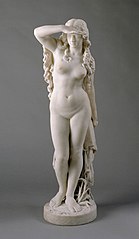 Aino, Looking Out to Sea, Johannes Takanen [fi], 1876
Aino, Looking Out to Sea, Johannes Takanen [fi], 1876
-
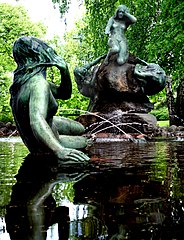 Aino Fountain in Lahti by Emil Wikström, 1912 (fi)
Aino Fountain in Lahti by Emil Wikström, 1912 (fi)
-
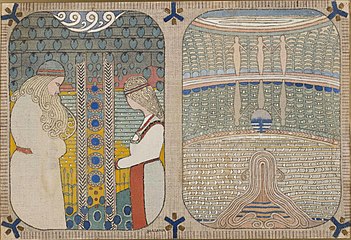 Courting of Aino and Aino Drowns Herself, Joseph Alanen [fi], 1908–1910
Courting of Aino and Aino Drowns Herself, Joseph Alanen [fi], 1908–1910
-
 Maidens at the Headlands, Joseph Alanen, 1919–1920
Maidens at the Headlands, Joseph Alanen, 1919–1920
References
- Tervola, Marjut (22 January 2016). "Mitä Väinämöinen todella teki? - Tätä tekoa #lääppijä-keskustelussa käytetty Aino-teos kuvasi". Yle. Retrieved 25 July 2020.
- Makkonen, Nita (5 February 2018). ""Eikö museota yhtään hävetä?" – Akseli Gallen-Kallelan Aino-taru joutui Me Too -kampanjan hampaisiin – tiukka vastaus julki". Ilta-Sanomat. Retrieved 25 July 2020.
- Piela, Ulla (20 October 2002). "Aino". Kansallisbiografia. Retrieved 29 July 2020.
- "Gallen-Kallelan Aino-triptyykki Tampereen taidemuseoon". Tampereen Taidemuseo. 5 March 2020. Archived from the original on 21 February 2021. Retrieved 25 July 2020.
- Rautio, Tuulia (21 January 2017). "Gallen-Kallelan Ainoja onkin kaksi – tunnistatko erot?". Satakunnan Kansa. Retrieved 30 June 2020.
- The Kalevala, Cantos 3, 4, and 5.
- Kustaa Vilkuna:Etunimet.1976.Kustannusosakeyhtiö Otava. (On the name Aino)
| Gods | |
|---|---|
| Heroes | |
| Villains | |
| Others | |
| Places | |
| Things | |
| Works inspired by the Kalevala | |
| Other related |
|
This article related to Finnish paganism or mythology is a stub. You can help Misplaced Pages by expanding it. |